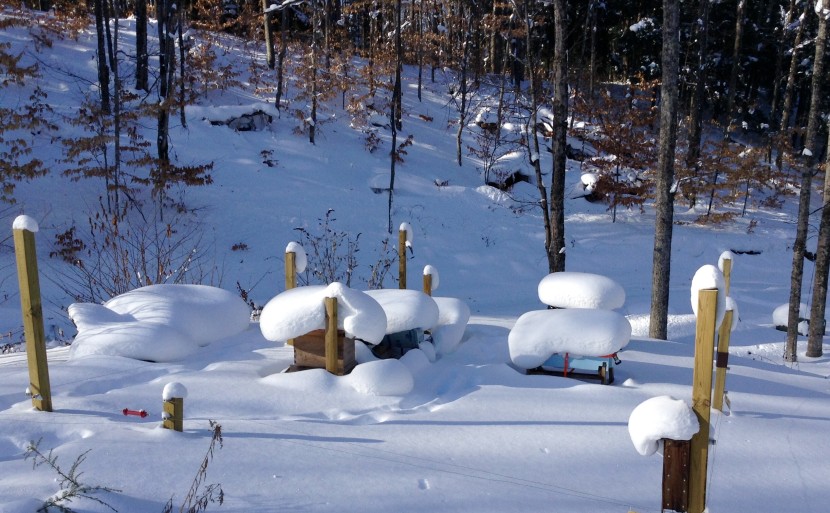Not actual beds, of course, but still, I put the bees to bed for the winter yesterday. I like to think that I’m getting better at Up North Beekeeping.
We hit 50 degrees yesterday, the Friday after Thanksgiving, and my hives were hopping. The bees were flying at five degrees less than the experts say they will. They were out and drinking from drops of water beaded on stems of grass. Also undertaking (the “Bring out your dead!” kind of undertaking). Worker bees dropped the corpses of their former companions and coworkers off the edge of the landing boards into neat piles below the hive entrances. Among the dead, drones vastly outnumbered workers. The honey stores can’t support those who have no function. Reproduction is on hold until spring and drones do no work. Drones even need to be fed to survive. So, during winter, they won’t.
Mike and I rescued some wet scout bees upside-down in roof puddles, their wings trapped by the surface tension of the water. Grateful, maybe, they wobbled off without threatening to sting us.
Two hives had an abundance of honey. The third was borderline, depending on the unknown severity of the coming season, so we installed a feeder in that one.
We reduced entrance sizes and stapled on mouse guards. Field mice like warmth and food. These beehives have both.
I lined their “attics” with burlap, to insulate and absorb condensation where cold air meets the warmth of the bee cluster. There’s nothing worse than wet and cold. Bees don’t like it any more than we do. We lost a hive to moisture last spring.
Finally, we made sure the hives had good air flow, then covered their rooftops with black plastic (poor man’s solar power) and strapped the roofs down against the Northwest gales.
Now for the hard part—leaving them alone.
Just letting them be.
Oh, I’ll patrol the apiary, checking to see that all’s well. I might find brown dots on the snow after they bees take advantage of a break in the weather for a cleansing run. Bees don’t poop inside the hive and, once the temperature plummets, they’ll wait until it’s safe to fly outside without dying. I’ll see signs of more bee deaths and undertaking. I’ll wonder “How many are too many?” I might put an ear to the hive to listen for them buzzing away in there. I’ll check the electric fences in the event a winter bear visits—one who fails to hibernate or gets hungry enough to sleepwalk toward the nearest snack.
I’ll watch the hives but I won’t open them. “Taking just a little peek” could be the death of the bees. Lifting the lid sends the internal temperature from the 90s to freezing in less time than it takes to write it. Torpor, or worse, death for my charges is too high a price for satisfying my curiosity.
Their survival now will be because of what they do as bees, not what I do as their keeper.
The workers will surround their queen in a cluster and fan their wings to circulate their body heat. The queen will remain warm and safe in the center of the “ball”. The workers will move gradually from the center to the circumference and back in, fanning as they go. Winter bees live long lives—the entire six or seven months of our long U.P. winters. Keeping themselves warm and well is all they have to do. No new bees will be raised until spring when the queen begins laying again. By contrast, spring and summer bees, who work hard in a sequence of jobs, have a life expectancy of six weeks. Summer bees wear out— essentially working themselves to death.
Winter bees have it easy and last longer. They’ll eat through their honey stores in the darkness of the hive until the queen senses spring and begets the next generation. If the winter workers do what they’re supposed to, all should be well.
I have to back away, knowing that I did all I could. Now’s the time to trust it was enough. In this, as in so much else, I can’t control the outcome.
The bees know what to do.
Their Maker is present.
Let it be.






Dare I say, “This is so sweet.” It shows such a balance between “We work” & “God gives the growth.” Thank you for this glimpse of life in your “ordinary” days.